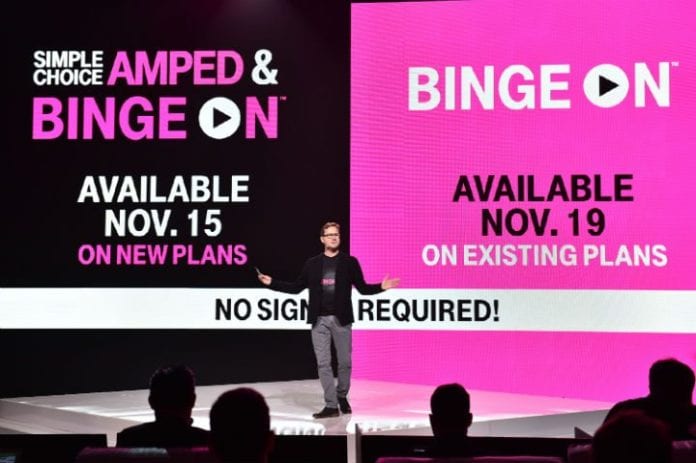A Strategy Analytics report found near universal acclaim for the T-Mobile Binge On video platform, which has since been folded into the One rate plan
T-Mobile US’ Binge On video-streaming platform is a winner with consumers, according to a new report from Strategy Analytics.
The research firm found 99% of smartphone users tapping into the video service claimed to be satisfied with the quality of mobile streaming. The platform, which was launched last year under the Binge On name and since folded into the carrier’s One rate plan, streams video content over T-Mobile US’ cellular network at 480-pixel video quality in its standard setting. Customers can now pay extra to have the service stream video at a higher quality.
The Strategy Analytics report said the findings came from SA’s AppOptix USA research platform using an opt-in panel of consumers, a telemetry application and big data analytics.
The results found 20% of T-Mobile US customers upgraded their rate plans in order to use the streaming video service, 14% of all wireless consumers said they were “very interested” or “extremely interested” in switching to T-Mobile US to take advantage of the streaming video service, and 68% of all wireless customers surveyed indicated “strong” or “moderate” interest in zero-rated streaming video at 480p quality.
“The survey results prove that Binge On has been a success for T-Mobile, helping to raise its [average revenue per user], increase mobile video usage and to give U.S. smartphone owners another reason to consider switching to T-Mobile,” wrote David Kerr, VP at Strategy Analytics. “Binge On has proved an important stage in the evolution from Simple Choice tariffs to T-Mobile One.”
The T-Mobile US service initially garnered some regulatory scrutiny as a potential violator of the Federal Communications Commission’s Open Internet rules. The FCC sent a letter to T-Mobile US seeking additional insight into the Binge On service, though FCC Chairman Tom Wheeler initially stated he did not think the service violated net neutrality or Open Internet provisions, indicating the offer was “highly innovative and highly competitive.” T-Mobile US earlier this year appeared to have soothed some content provider concerns by implementing content provider control over the video quality of the streamed content.
Imitation sincerest form of flattery
T-Mobile US rivals have, in various forms, jumped on the bandwagon of zero-rating streaming video content.
Sprint has been the most eager to copy T-Mobile US’ model, rolling out a video optimization package as part of its “Unlimited Freedom” rate plans designed to limit video streaming to 480p, or “DVD-like” quality. Sprint followed the launch with an offer for customers to stream video over its cellular network at higher-definition quality for an extra fee.
AT&T earlier this month moved to zero-rating streaming video content from its DirecTV and U-verse video platforms for its wireless customers, which now runs alongside its offer of “unlimited” data access for AT&T Mobility customers selecting one of the television services.
Verizon Wireless last week added streaming content through the NFL Mobile application to its previously offered zero-rating of video content through its Go90 video platform.
Bored? Why not follow me on Twitter

